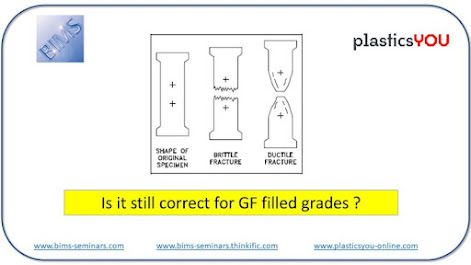Today's KNOWLEDGE Share:
GF Filled Polymer
Let's imagine we do a fatigue test on a 40% GF filled polymer. Visually, such material will always show what appears to be a brittle failure.
Even a less severe quasi-static tensile test will typically show failure at 1 or 1.5 % strain, which we mentally associate with "BRITTLE FAILURE".
However, you'd be surprised to see to what an extent such failures are largely due to plasticity/ductile mechanisms.
If we do our fatigue test (with a classic stress ratio R=0.1 ) at 1 Hz and then we repeat it on a fresh sample at 2 Hz, very often we will observe that life-time is the same, despite doubling the number of cycles ! This indicates that failure is essentially controlled by the underlying creep and accumulated plastic strain. A totally ductile mechanism !
If we were to observe failure two times faster, i.e. at the same number of cycles, this would point towards a dominant crack growth/brittle mechanism.
In real life, we may also find something in between, demonstrating that failure mechanisms are often the result of concurrent damage mechanisms involving plasticity and cavitation. This is what modern "progressive damage" models (e-Xstream engineering, part of Hexagon’s Manufacturing Intelligence division for instance) will implement.
Source:VITO LEO
Visit MY BLOG http://polymerguru.blogspot.com
#polymers #plasticsengineering #glassfiber #damage #fracture #tensile #crack #polymerscience





No comments:
Post a Comment